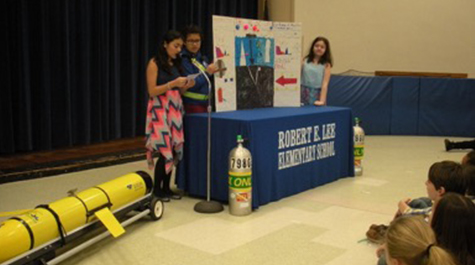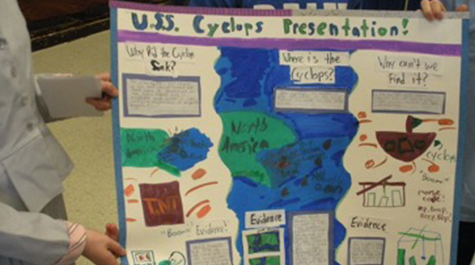STEM Education Alliance and VIMS partner to provide unique learning experience
On February 10, 2017, the STEM Education Alliance at the School of Education partnered with the Virginia Institute of Marine Science (VIMS) to support a problem-based learning (PBL) experiment in Spotsylvania, Virginia, at Robert E. Lee Elementary School. This STEM-centered PBL experiment, titled “The Search for the USS Cyclops,” was led by fifth grade teacher Kaitlyn Boyle and involved 75 students. The STEM Education Alliance and VIMS worked with Ms. Boyle to develop the experience.
The activity centered on the mystery of the USS Cyclops, a U.S. Naval vessel that sunk, along with her 306 crew and passengers, without a trace in the Bermuda Triangle in 1918. The ultimate cause of the ship's fate is unknown.
The PBL activity asked students to research and form theories based on three essential questions: (1) How did the USS Cyclops sink? (2) Where is the Cyclops now? (3) Why has it been so hard to locate? The final project involved groups of two or three students presenting their theories and supporting evidence to a panel of scientific experts from the STEM Education Alliance and VIMS, including Dr. Donglai Gong and Lauren Ferris, marine science engineer.
The students enjoyed taking control of their own learning and discussing their findings with professionals currently working on similar projects. In order to come up with theories and supporting evidence to the questions presented in the PBL activity, the student groups performed a variety of experiments during a nine-week period. These experiments included building a warm- vs. cold-water food color test; illustrating surface currents with straws and glitter; building a clay model to illustrate the levels of the ocean, including the Abyssal Plain; investigating fresh water, brackish water, and salt water in a density column; and using wavelength goggles to locate the visible light spectrum through water. Through these experiments, several Virginia Standards of Learning (SOL) topics were targeted, such as neap tides, tectonic plate movements, vertebrate and invertebrate predators, density of water, and ocean currents.
Lauren Ferris, a marine science engineer at the Coastal and Polar Physical Oceanography Lab at VIMS, volunteered her time for the day. She brought along a Slocum G2 underwater glider and Nitrox scuba tanks to explain buoyancy and underwater ocean exploration techniques. Lauren led an hour-long Q&A session related to her work with the underwater glider and her career as a female professional engineer working at VIMS. Students had a chance to ask questions about her current career and the path that led her to becoming an engineer working in Dr. Donglai Gong’s lab at VIMS. Greg Marsh, project specialist at the STEM Education Alliance, was able to help connect what Laura was doing in the field to the SOL objectives that were covered throughout the PBL experiment.



